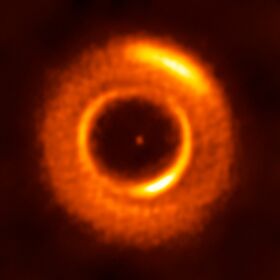Astronomy:HD 36112
Coordinates: ![]() 05h 30m 27.52868s, +25° 19′ 57.0822″
05h 30m 27.52868s, +25° 19′ 57.0822″
 HD 36112 and the surrounding dusty disk. The rings in the disk were measured as being elliptical in shape rather than being perfectly circular. Credit: ESO/R. Dong et al.; ALMA (ESO/NAOJ/NRAO) | |
| Observation data Equinox J2000.0]] (ICRS) | |
|---|---|
| Constellation | Taurus |
| Right ascension | 05h 30m 27.52856s[1] |
| Declination | +25° 19′ 57.0763″[1] |
| Characteristics | |
| Spectral type | A8Ve[2] |
| Astrometry | |
| Proper motion (μ) | RA: 3.685(33)[1] mas/yr Dec.: −26.373(22)[1] mas/yr |
| Parallax (π) | 6.4157 ± 0.0314[1] mas |
| Distance | 508 ± 2 ly (155.9 ± 0.8 pc) |
| Other designations | |
| Database references | |
| SIMBAD | data |
HD 36112, also known as MWC 758, is a young Herbig Ae star located in the constellation Taurus, surrounded by irregular rings of cosmic dust. The system is about 3.5 million years old. The disk has a cavity at 50 astronomical units and two spiral arms at 30-75 au that are seen in near-infrared scattered light, but only one spiral arm is seen in ALMA images.[3][4]
The inner cavity was shown to be elliptical and not perfectly circular. This is not a projection effect but represents the shape of the cavity, with an eccentricity e ≈ 0.1 after the deprojection of the disk.[4]
A 2018 study detected a possible exoplanet at a distance of about 20 au, designated MWC 758 b,[5] and the observations with ALMA have also shown evidence of an unseen planet at 100 au.[4] A study in 2019 came to the conclusion that a 1.5 |♃|J}}}}}} planet at 35 au and a 5 MJ planet at 140 au could explain the features seen with ALMA and the VLA.[6]
In another 2019 study, a possible exoplanet or disk feature was detected with the Large Binocular Telescope, referred to as MWC 758 CC1 (Companion Candidate 1), with a non-detection of MWC 758 b.[7] However, another study in 2021 failed to detect either of the point sources found in earlier studies.[8] A 2023 study found further evidence for MWC 758 CC1, now designated MWC 758 c, orbiting at a distance of approximately 100 au.[9]
References
- ↑ 1.0 1.1 1.2 1.3 Vallenari, A. et al. (2022). "Gaia Data Release 3. Summary of the content and survey properties". Astronomy & Astrophysics. doi:10.1051/0004-6361/202243940 Gaia DR3 record for this source at VizieR.
- ↑ Vieira, S. L. A; Corradi, W. J. B; Alencar, S. H. P; Mendes, L. T. S; Torres, C. A. O; Quast, G. R; Guimares, M. M; Da Silva, L (2003). "Investigation of 131 Herbig Ae/Be Candidate Stars". The Astronomical Journal 126 (6): 2971. doi:10.1086/379553. Bibcode: 2003AJ....126.2971V.
- ↑ "ALMA spies a new planetary nursery". https://www.eso.org/public/images/potw1827a/.
- ↑ 4.0 4.1 4.2 Dong, Ruobing; Liu, Sheng-yuan; Eisner, Josh; Andrews, Sean; Fung, Jeffrey; Zhu, Zhaohuan; Chiang, Eugene; Hashimoto, Jun et al. (June 2018). "The Eccentric Cavity, Triple Rings, Two-armed Spirals, and Double Clumps of the MWC 758 Disk" (in en). Astrophysical Journal 860 (2): 124. doi:10.3847/1538-4357/aac6cb. ISSN 0004-637X. Bibcode: 2018ApJ...860..124D.
- ↑ Reggiani, M. et al. (March 2018). "Discovery of a point-like source and a third spiral arm in the transition disk around the Herbig Ae star MWC 758". Astronomy & Astrophysics 611: A74. doi:10.1051/0004-6361/201732016. Bibcode: 2018A&A...611A..74R.
- ↑ Baruteau, Clément; Barraza, Marcelo; Pérez, Sebastián; Casassus, Simon; Dong, Ruobing; Lyra, Wladimir; Marino, Sebastián; Christiaens, Valentin et al. (June 2019). "Dust traps in the protoplanetary disc MWC 758: two vortices produced by two giant planets?" (in en). MNRAS 486 (1): 304–319. doi:10.1093/mnras/stz802. ISSN 0035-8711. Bibcode: 2019MNRAS.486..304B.
- ↑ Wagner, Kevin; Stone, Jordan M.; Spalding, Eckhart; Apai, Daniel; Dong, Ruobing; Ertel, Steve; Leisenring, Jarron; Webster, Ryan (September 2019). "Thermal Infrared Imaging of MWC 758 with the Large Binocular Telescope: Planetary-driven Spiral Arms?" (in en). Astrophysical Journal 882 (1): 20. doi:10.3847/1538-4357/ab32ea. ISSN 0004-637X. Bibcode: 2019ApJ...882...20W.
- ↑ Boccaletti, A.; Pantin, E.; Ménard, F.; Galicher, R.; Langlois, M.; Benisty, M.; Gratton, R.; Chauvin, G. et al. (2021). "Investigating point sources in MWC 758 with SPHERE". Astronomy & Astrophysics 652: L8. doi:10.1051/0004-6361/202141177. Bibcode: 2021A&A...652L...8B.
- ↑ Wagner, Kevin et al. (July 2023). "Direct images and spectroscopy of a giant protoplanet driving spiral arms in MWC 758". Nature Astronomy 7 (10): 1208–1217. doi:10.1038/s41550-023-02028-3. Bibcode: 2023NatAs...7.1208W.
 |

